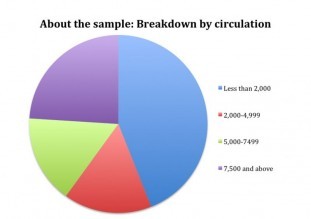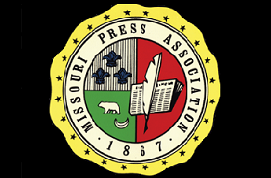By Mike Jenner
Houston Harte Chair
Missouri School of Journalism
Despite an unfriendly economy and changes in reader and advertiser behavior, most weekly publishers are
bullish on the future of community newspapers. In a recent survey, 72 percent expressed optimism about the
future of newspapers. And while they see some promise in digital revenue, they believe print will play an
enduring role: two-thirds don’t envision a time when they’ll no longer produce a print edition.
While weekly papers haven’t moved as quickly as the dailies into creating mobile phone and tablet apps, they
have kept pace with smaller dailies in the adoption of paid online models.
The survey of publishers shows that 42 percent of non-daily newspapers now charge users for digital content. A similar study last April showed that 46 percent of publishers of dailies under 25,000 circulation require
payment for at least some of their online content. Of weekly newspapers that don’t now charge, one quarter of their publishers say they plan to launch a paid program in the next 12 months; another 48 percent say they may begin charging after that.
The extensive survey of publishers was paid for by the Southern Newspaper Publishers Association and the
Missouri School of Journalism’s Houston Harte Chair. Using the database of non-daily newspapers provided
by the National Newspaper Association, more than 400 in-depth telephone interviews were conducted in
October by the Center for Advanced Social Research, the research arm of the Reynolds Journalism Institute at
the Missouri School of Journalism. The survey had an 85 percent response rate.
Positive attitudes: Economic challenges and changes in advertiser and consumer habits haven’t shaken the
faith of most weekly publishers. Nearly three in four — 72 percent — express optimism about the future of the
industry. Another 21 percent are neutral; only 7 percent say they were not optimistic.
Like their daily counterparts, publishers of non-dailies envision a strong shift in the makeup of their papers’
revenue streams from print to digital. At present, 80 percent say less than 10 percent of their revenue is
attributable to digital. In three years, only 41 percent believe digital will make up less than 10 percent of total revenue.
Forty-two percent believe their digital stream will range between 10 and 24 percent in three years; at present
only 18 percent say digital revenue falls in that range. And 17 percent of publishers envision digital revenue in
three years exceeding 25 percent of total revenue — only 2 percent say they are in that range today.
All the redistribution of revenue will come at the expense of print, publishers say. They see little change in the relative contribution of other revenue components, including outside printing and niche products.
Mobile and tablet efforts: Weeklies trail dailies in development of mobile phone and tablet products. While
28 percent of non-daily publishers said they offered a mobile-optimized website, less than 1 in 10 — 7 percent –now have a native app for any kind of mobile phone. And only 3 percent offer a tablet app of any kind.
Of those organizations that don’t now have a mobile phone app, 28 percent plan to create one in the coming 12 months, and 37 percent of them plan to charge for it. In the coming 12 months, 26 percent of those newspapers without a tablet app plan to create one; 56 percent of them plan to charge for it.
External forces at play: The absence of ubiquitous broadband internet access across weekly markets and the
competition for readers and advertisers are behind some of the decisions to implement paid content and mobile platforms and products. Thirty-six percent of weekly publishers say their market is not saturated with broadband internet coverage. Another 33 percent say their markets are saturated; while 31 percent are neutral.
Publishers see greater competition in their markets for ad dollars than for news coverage: Only 24
percent say they’re in a competitive news market. But the perception of competition for advertising is a different story: 47 percent of publishers say they’re in competitive advertising markets. One quarter say their markets are not competitive for advertising; another 28 percent are neutral. But the perception of competition for advertising is a different story: 47 percent of publishers say they’re in competitive advertising markets. One quarter say their markets are not competitive for advertising; another 28 percent are neutral.
Forging ahead with paid content: The non-daily papers — nearly all of them weekly or twice-weekly
community papers — were undaunted by technical challenges: Nearly three-quarters (74 percent) implemented their pay-for-content mechanisms themselves, while the remainder joined a syndicate or vendor-created network. Until the widespread advent of paid content models, most dailies put the entire local contents of their print edition on their websites for free, often adding material such as blogs, slideshows and video. But many weeklies have gone a different route, being loath to post all local content online for free. In part to protect print editions, 26 percent of all weeklies have offered less on the web, using their sites to promote or tease local content, or simply list information about how to contact the paper. An equal proportion offers a replica edition; 48 percent offer more than their print edition.
Nearly half — 47 percent — of the weeklies bundle free access to their web editions with print subscriptions. One quarter offer a metered approach. In all, 36 percent of non-daily publishers believe revenue from their paid content models will account for up to 20 percent of digital revenue; 15 percent believe it will represent more than 20 percent. About half thought it would have a negligible effect.
While most publishers expect their paid content model to have no effect on print circulation, 7 percent think it will increase circulation and 24 percent think it will slow or stop circulation declines. E-editions, or PDF replicas of the print edition that can be emailed to customers, play an important role in the
digital portfolio of weeklies. One in six — 17 percent — offer e-editions; all are charging for them.
Ninety-five percent of weeklies with more than 5,000 circulation have websites, compared to 77 percent of
those with less than 5,000 circulation.
Digital Sales, ad production, and training: In nearly 4 of 5 weeklies, sales representatives sell a full
portfolio of print and digital products. One-fifth of the newspapers have at least one sales staffer who specializes in one or the other. In nearly half the organizations — 43 percent — sales reps also are responsible for ad creation and production. Circulation size was not a significant factor. However, only one-third of publishers of newspapers in which sales staffs sell both print and digital believe their representatives can sell digital products as well as print. More than two-thirds — 68 percent — believe specific training in selling digital products would make a significant difference in sales results. Publishers also feel journalists need more ongoing training in digital news coverage and production. Forty seven percent say their newsrooms need ongoing training. And 44 percent cite the need for ongoing training in digital ad production.

55% in privately owned groups 44% independent non-group 1% in publicly traded groups
Average news staff size was 7.5; staff size ranged from 1 to 150.


